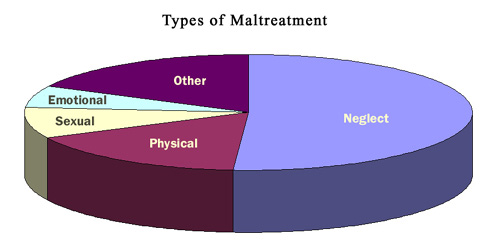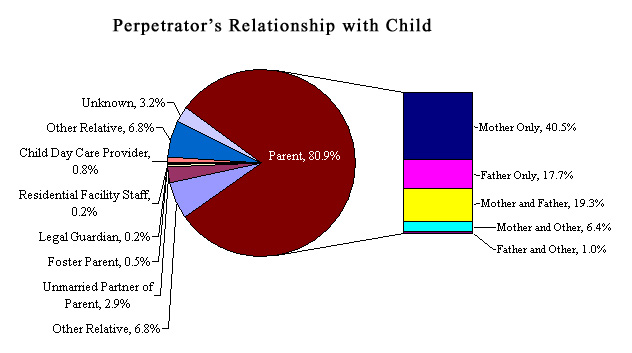
Child abuse is a major public health concern that transcends
racial, ethnic, religious, and socioeconomic boundaries. It has been correlated
with problems of violence, substance abuse, anxiety disorders, depression,
suicide, and other psychopathology. Studies suggest that the incidence of
certain comorbidities are correlated with duration and severity of abuse,
thus suggesting that reports of abuse to appropriate child protection agencies
may have long term, as well as immediate, health benefits for the victim.
Thus, it is essential that pediatricians and other healthcare providers understand
the scope of the problem and how to identify cases of abuse and neglect, as
well as families at risk. Here we outline the scope of the problem.
Descriptions:
Most of the following descriptions are adapted from the U.S. Department of
Health and Human Services guide, “A Coordinated Response to Child Abuse
and Neglect: A Basic Manual.”(2)
 Physical Abuse: characterized
by physical injury (i.e. bruises and fractures) resulting from punching, beating,
kicking, biting, burning, or otherwise harming a child. Although the injury
is not an accident, the parent or caretaker may not have intended to hurt
the child. The injury may have resulted from overdiscipline or physical punishment
that is inappropriate for the child’s age or condition. The injury may
be a result of a single episode or of repeated episodes and can range in severity
from minor bruising to death. Any punishment that involves hitting with a
closed fist or an instrument, kicking, inflicting burns, or throwing the child
is considered physical abuse regardless of the severity of the injury sustained.
Physical Abuse: characterized
by physical injury (i.e. bruises and fractures) resulting from punching, beating,
kicking, biting, burning, or otherwise harming a child. Although the injury
is not an accident, the parent or caretaker may not have intended to hurt
the child. The injury may have resulted from overdiscipline or physical punishment
that is inappropriate for the child’s age or condition. The injury may
be a result of a single episode or of repeated episodes and can range in severity
from minor bruising to death. Any punishment that involves hitting with a
closed fist or an instrument, kicking, inflicting burns, or throwing the child
is considered physical abuse regardless of the severity of the injury sustained.
 Sexual Abuse: includes
a wide range of behavior - fondling a child’s genitals, oral-genital
contact, intercourse, rape, sodomy, forcing a child to perform a sexual act
on an adult, exhibitionism, and commercial exploitation through prostitution
or the production of pornographic materials. Sexual abuse is usually defined
as acts committed by a person responsible for the care of the child (i.e.
a parent, babysitter, day care provider, etc.), whereas sexual assault is
usually defined as acts committed by a person not responsible for the child’s
care.
Sexual Abuse: includes
a wide range of behavior - fondling a child’s genitals, oral-genital
contact, intercourse, rape, sodomy, forcing a child to perform a sexual act
on an adult, exhibitionism, and commercial exploitation through prostitution
or the production of pornographic materials. Sexual abuse is usually defined
as acts committed by a person responsible for the care of the child (i.e.
a parent, babysitter, day care provider, etc.), whereas sexual assault is
usually defined as acts committed by a person not responsible for the child’s
care.
 Emotional/Psychological
Abuse: includes acts or omissions by the parents or other persons responsible
for the child’s care that have caused, or could cause, serious behavioral,
cognitive, emotional, or mental disorders. In some cases, the acts alone (without
any harm evident in the child’s behavior or condition) warrant Department
of Social Services (DSS) intervention; for example, the use of extreme or
bizarre forms of punishment, such as torture or confinement in a dark closet.
For less severe acts, such as habitual scapegoating, belittling, or rejecting
treatment, demonstrable harm to the child is often required for DSS to intervene.
Emotional/Psychological
Abuse: includes acts or omissions by the parents or other persons responsible
for the child’s care that have caused, or could cause, serious behavioral,
cognitive, emotional, or mental disorders. In some cases, the acts alone (without
any harm evident in the child’s behavior or condition) warrant Department
of Social Services (DSS) intervention; for example, the use of extreme or
bizarre forms of punishment, such as torture or confinement in a dark closet.
For less severe acts, such as habitual scapegoating, belittling, or rejecting
treatment, demonstrable harm to the child is often required for DSS to intervene.
 Physical Neglect: includes
refusal of or delay in seeking health care, abandonment, inadequate supervision,
and expulsion from home or refusing to allow a runaway to return home.
Physical Neglect: includes
refusal of or delay in seeking health care, abandonment, inadequate supervision,
and expulsion from home or refusing to allow a runaway to return home.
 Emotional Neglect:
includes such actions as chronic or extreme spouse abuse in the child’s
presence, permission of drug or alcohol use by the child, and refusal or failure
to provide needed psychological care.
Emotional Neglect:
includes such actions as chronic or extreme spouse abuse in the child’s
presence, permission of drug or alcohol use by the child, and refusal or failure
to provide needed psychological care.
 Educational Neglect:
includes permission of chronic truancy, failure to enroll a child of mandatory
school age, and inattention to a special education need.
Educational Neglect:
includes permission of chronic truancy, failure to enroll a child of mandatory
school age, and inattention to a special education need.
 Munchausen Syndrome by
Proxy: a form of child abuse in which a parent (usually the mother) purposefully
fabricates illness in her child or reports concerning symptoms (such as seizure
activity, apnea, etc.) not seen by objective witnesses, and repeatedly seeks
medical care for the child, denying knowledge as to the cause of the illness
or injury. Acute signs and symptoms often subside when child and parent are
separated.(3)
Munchausen Syndrome by
Proxy: a form of child abuse in which a parent (usually the mother) purposefully
fabricates illness in her child or reports concerning symptoms (such as seizure
activity, apnea, etc.) not seen by objective witnesses, and repeatedly seeks
medical care for the child, denying knowledge as to the cause of the illness
or injury. Acute signs and symptoms often subside when child and parent are
separated.(3)
For more detailed descriptions, please see Injuries
and Behaviors Indicative of Abuse.
Top
Statistics:
The National Child Abuse and Neglect Data System (NCANDS)(4)
reported the following statistics for the calendar year 2001:
 Incidence:
Incidence:
An estimated 903,000 (12.4 per 1,000) children in the United States were
victims of child maltreatment in the year 2001. These numbers increased
slightly from the year 2000, when an estimated 879,000 (12.2 per 1,000)
children were abused and/or neglected.
 Types of Maltreatment:
Types of Maltreatment:
Of those children maltreated,

